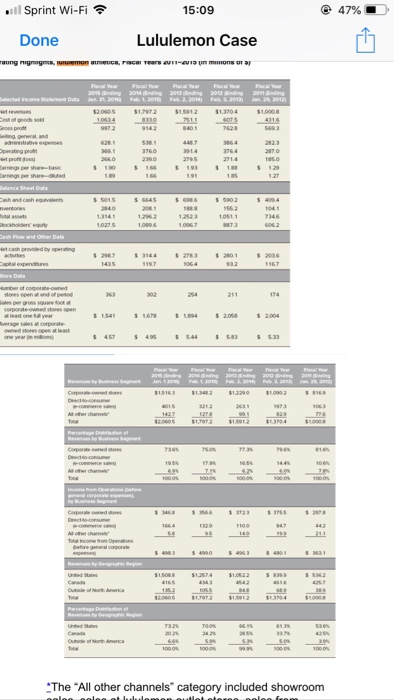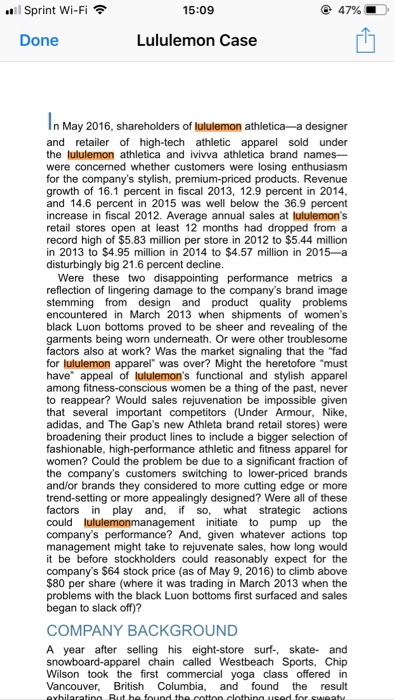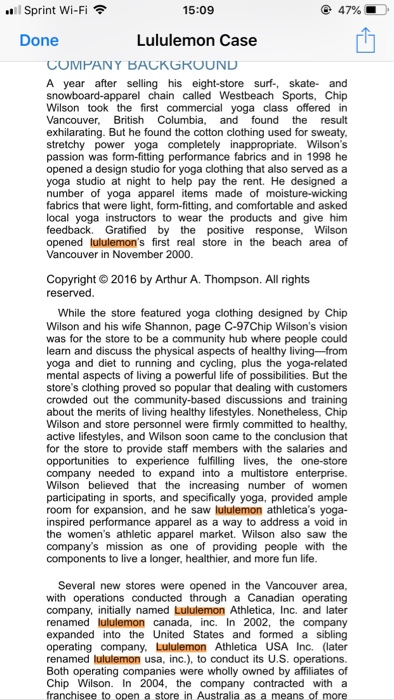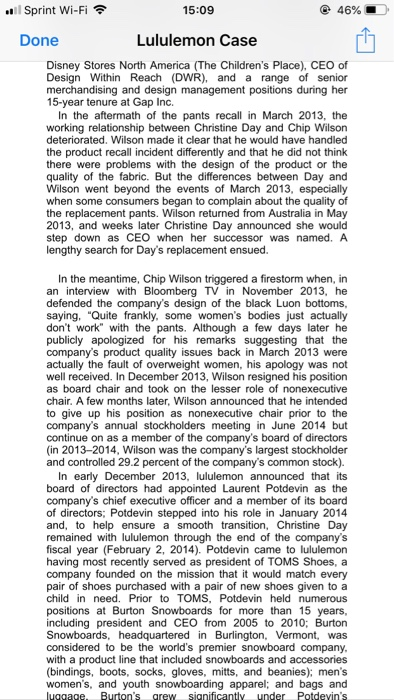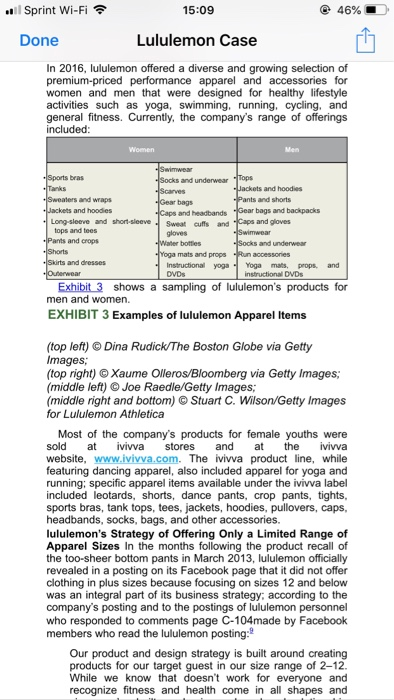8. What do the data in case Exhibit 1 reveal about Lululemon's financial and operating performance? You should use the financial ratios in Table 4.1 of Chapter 4 in performing calculations to determine which aspects of Lululemon's financial performance might be characterized as impressive, improving, or not. In addition to the ratios in Table 4.1, you will also need to calculate compound average growth rates (CAGR) for certain financial measures. The formula for calculating CAGR (in percentage terms) is as follows: .11 Sprint Wi-Fi 15:09 47% Done Lululemon Case un muions or a Ending 20m 2.04051.7972 $15012$1.3704 2523 1051 by operating 31442783 2801203 pesod s 1.541 s 457 1,0622 The "All other channels category included showroom Sprint Wi-Fi 15:09 47% Done Lululemon Case n May 2016, shareholders of lululemon athletica-a designer and retailer of high-tech athletic apparel sold under the lululemon athletica and ivivva athletica brand names- were concerned whether customers were losing enthusiasm for the company's stylish, premium-priced products. Revenue growth of 16.1 percent in fiscal 2013, 12.9 percent in 2014 and 14.6 percent in 2015 was well below the 36.9 percent increase in fiscal 2012. Average annual sales at lululemon's retail stores open at least 12 months had dropped from a record high of $5.83 million per store in 2012 to $5.44 million in 2013 to $4.95 million in 2014 to $4.57 million in 2015-a disturbingly big 21.6 percent decline. Were these two disappointing performance metrics a reflection of lingering damage to the company's brand image stemming from design and product quality problems encountered in March 2013 when shipments of women's black Luon bottoms proved to be sheer and revealing of the garments being worn underneath. Or were other troublesome factors also at work? Was the market signaling that the "fad for lululemon apparel" was over? Might the heretofore "must have" appeal of lululemon's functional and stylish apparel among fitness-conscious women be a thing of the past, never to reappear? Would sales rejuvenation be impossible given that several important competitors (Under Armour, Nike adidas, and The Gap's new Athleta brand retail stores) were broadening their product lines to include a bigger selection of fashionable, high-performance athletic and fitness apparel for women? Could the problem be due to a significant fraction of the company's customers switching to lower-priced brand and/or brands they considered to more cutting edge or more trend-setting or more appealingly designed? Were all of these factors in play and, if so, what strategic actions could lululemonmanagement initiate to pump up the company's performance? And, given whatever actions top management might take to rejuvenate sales, how long would it be before stockholders could reasonably expect for the company's $64 stock price (as of May 9, 2016) to climb above $80 per share (where it was trading in March 2013 when the blems with the black Luon bottoms first surfaced and sales began to slack off)? COMPANY BACKGROUND A year after selling his eight-store surf-, skate- and snowboard-apparel chain called Westbeach Sports, Chip Wilson took the first commercial yoga class offered in Vancouver, British Columbia, and found the result Sprint Wi-Fi 15:09 47% Done Lululemon Case COMPANY BACKGROUND A year after selling his eight-store surf, skate- and snowboard-apparel chain called Westbeach Sports, Chip Wilson took the first commercial yoga class offered in Vancouver. British Columbia, and found the result exhilarating. But he found the cotton clothing used for sweaty, stretchy power yoga completely inappropriate. Wilson's passion was form-fitting performance fabrics and in 1998 he opened a design studio for yoga clothing that also served asa yoga studio at night to help pay the rent. He designed a number of yoga apparel items made of fabrics that were light, form-fitting, and comfortable and asked local yoga instructors to wear the products and give him feedback. Gratified by the positive response, Wilson opened lululemon's first real store in the beach area of Vancouver in November 2000 Copyright 2016 by Arthur A. Thompson. All rights reserved While the store featured yoga clothing designed by Chip Wilson and his wife Shannon, page C-97Chip Wilson's vision was for the store to be a community hub where people could learn and discuss the physical aspects of healthy living-fromm yoga and diet to running and cycling, plus the yoga-related mental aspects of living a powerful life of possibilities. But the store's clothing proved so popular that dealing with customers crowded out the about the merits of living healthy lifestyles. Nonetheless, Chip Wilson and store personnel were firmly committed to healthy active lifestyles, and Wilson soon came to the conclusion that for the store to provide staff members with the salaries and opportunities to experience fulfilling lives, the one-stone company needed to expand into a multistore enterprise Wilson believed that the increasing number of women participating in sports, and specifically yoga, provided ample room for expansion, and he saw lululemon athletica's yoga- inspired performance apparel as a way to address a void in the women's athletic apparel market. Wilson also saw the company's mission as one of providing people with the components to live a longer, healthier, and more fun life. ommun discussions and training Several new stores were opened in the Vancouver area, with operations conducted through a Canadian operating company, initially named Lululemon Athletica, Inc. and later renamed lululemon canada, inc. In 2002, the company expanded into the United States and formed a sibling operating company, Lululemon Athletica USA Inc. (later renamed lululemon usa, inc.), to conduct its U.S. operations. Both operating companies were wholly owned by affiliates of Chip Wilson. In 2004, the company contracted with a franchisee to open a store in Australia as a means of more Sprint Wi-Fi 15:09 @ 46% Done Lululemon Case The "All other channels" category included showroom sales, sales at lululemon outlet stores, sales from temporary store locations, licensing revenues, and wholesale sales to premium yoga studios, health clubs fitness centers, and other wholesale accounts. Sources: Company 10-K reports, fiscal years 2011, 2012 2013, 2014, and 2015 lululemon's Evolving Senior Leadership Te In January 2008, Christine M. Day joined the company as executive vice president, retail operations. Previously, she had worked at Starbucks, functioning in a variety of capacities and positions including president, Asia Pacific Group (July 2004-February 2007), co-president, Starbucks Coffee International (July 2003-October 2003), and senior vice president, North American Finance & Administration, and vice president, sales and operations for business alliances. In April 2008, Day was appointed as lululemon's president and chief operating officer, and was named chief executive officer and member of the board of directors in July 2008. During her tenure as CEO, Day expanded and strengthened the company's management team to support its expanding operating activities and geographic scope, favoring the addition of people with relevant backgrounds and experiences at such companies as Nike, Abercrombie & Fitch, The Gap and Speedo International. She also spent a number of hours each week in the company's stores observing how customers shopped, listening to their comments and complaints, and using the information to tweak product offerings, merchandising, and store operations Company founder Chip Wilson stepped down from his executive role as lululemon's chief innovation and branding officer effective January 29, 2012, and moved his family to Australia; however, he continued on in his role as chair of the company's board of directors and focused on becominga better board chair, even going so far as to take a four-day course on board governance Northwestern University.1 Christine Day promoted Sheree Waterson, who had joined the company in 2008 and had over 25 years of consumer and retail industry experience, as chief product officer to assume responsibility for product design, product development, and other executive tasks that Wilson had been performing. Shortly after the quality problems with the black Luon bottoms occurred, Waterson resigned her position and left the company. In October 2013, lululemon announced that Tara Poseley had been appointed to its Senior Leadership Team as chief product officer and would have responsibility for overseeing lululemon's design team, product design activities, merchandising, inventory activities, and strategic .'ll Sprint Wi-Fi 15:09 @ 46% Done Lululemon Case Disney Stores North America (The Children's Place), CEO of Design Within Reach (DWR), and a range of senior merchandising and design management positions during her 15-year tenure at Gap Inc. In the aftermath of the pants recall in March 2013, the working relationship between Christine Day and Chip Wilson deteriorated. Wilson made it clear that he would have handled the product recall incident differently and that he did not think there were problems with the design of the product or the quality of the fabric. But the differences between Day and Wilson went beyond the events of March 2013, especially when some the replacement pants. Wilson returned from Australia in May 2013, and weeks later Christine Day announced she would step down as CEO when her successor was named. A lengthy search for Day's replacement ensued. consumers began to complain about the q uality of In the meantime, Chip Wilson triggered a firestorm when, in an interview with Bloomberg TV in November 2013, he defended the company's design of the black Luon bottoms, saying, "Quite frankly, some women's bodies just actually don't work" with the pants. Although a few days later he publicly apologized for his remarks suggesting that the company's product quality issues back in March 2013 were actually the fault of overweight women, his apology was not well received. In December 2013, Wilson resigned his position as board chair and took on the lesser role of nonexecutive chair. A few months later, Wilson announced that he intended to give up his position as nonexecutive chair prior to the company's annual stockholders meeting in June 2014 but continue on as a member of the company's board of directors (in 2013-2014, Wilson was the company's largest stockholder and controlled 29.2 percent of the company's common stock) In early December 2013, lululemon announced that its board of directors had appointed Laurent Potdevin as the company's chief executive officer and a member of its board of directors; Potdevin stepped into his role in January 2014 and, to help ensure a smooth transition, Christine Day remained with lululemon through the end of the company's fiscal year (February 2, 2014). Potdevin came to lululemon having most recently served as president of TOMS Shoes, a company founded on the mission that it would match every pair of shoes purchased with a pair of new shoes given to a child in need. Prior to TOMS, Potdevin held numerous positions at Burton Snowboards for more than 15 years, including president and CEO from 2005 to 2010: Burton Snowboards, headquartered in Burlington, Vermont, considered to be the world's premier snowboard company with a product line that included snowboards and accessories (bindings, boots, socks, gloves, mitts, and beanies); men's apparel; and bags and Burton's arew significantly under Potdevin's women's, and youth Sprint Wi-Fi @ 46%-D. 15:09 1 Done Lululemon Case In 2016, lululemon offered a diverse and growing selection of premium-priced performance apparel and accessories for women and men that were designed for healthy lifestyle activities such as yoga, swimming, running, cycling, and general fitness. Currently, the company's range of offerings included: bras Socks and underwear and hoodies and wraps Jackets and hoodies Gear bags Caps and headbands "Gear bags and backpacks and Long-sleeve and shont-sleev tops and tees Sweat cuffs Pants and crops and underwear oga mats and props Skirts and dresses Instructional yoga Yoga mats, props, and instructional DVDs Exhibit 3 shows a sampling of lululemon's products for men and women. EXHIBIT 3 Examples of lululemon Apparel Items (top left) Dina Rudick/The Boston Globe via Getty Images (top right) Xaume Olleros/Bloomberg via Getty Images; (middle left) Joe Raedle/Getty Images (middle right and bottom) Stuart C. Wilson/Getty Images for Lululemon Athletica Most of the company's products for female youths were sold at ivivva stores and the ivivva website, www.ivivva.com. The ivivva product line, while featuring dancing apparel, also included apparel for yoga and running; specific apparel items available under the ivivva label included leotards, shorts, dance pants, crop pants, tights, sports bras, tank tops, tees, jackets, hoodies, pullovers, caps, headbands, socks, bags, and other accessories. lululemon's Strategy of Offering Only a Limited Range of Apparel Sizes In the months following the product recall of the too-sheer bottom pants in March 2013, lululemon officially revealed in a posting on its Facebook page that it did not offer clothing in plus sizes because focusing on sizes 12 and below was an integral part of its business strategy: according to the company's posting and to the postings of lululemon personnel who responded to comments page C-104made by Facebook members who read the lululemon posting: Our product and design strategy is built around creating ucts for our target guest in our size range of 2-12. le we know that doesn't work for everyone and recognize fitness and health come in all shapes and 8. What do the data in case Exhibit 1 reveal about Lululemon's financial and operating performance? You should use the financial ratios in Table 4.1 of Chapter 4 in performing calculations to determine which aspects of Lululemon's financial performance might be characterized as impressive, improving, or not. In addition to the ratios in Table 4.1, you will also need to calculate compound average growth rates (CAGR) for certain financial measures. The formula for calculating CAGR (in percentage terms) is as follows: .11 Sprint Wi-Fi 15:09 47% Done Lululemon Case un muions or a Ending 20m 2.04051.7972 $15012$1.3704 2523 1051 by operating 31442783 2801203 pesod s 1.541 s 457 1,0622 The "All other channels category included showroom Sprint Wi-Fi 15:09 47% Done Lululemon Case n May 2016, shareholders of lululemon athletica-a designer and retailer of high-tech athletic apparel sold under the lululemon athletica and ivivva athletica brand names- were concerned whether customers were losing enthusiasm for the company's stylish, premium-priced products. Revenue growth of 16.1 percent in fiscal 2013, 12.9 percent in 2014 and 14.6 percent in 2015 was well below the 36.9 percent increase in fiscal 2012. Average annual sales at lululemon's retail stores open at least 12 months had dropped from a record high of $5.83 million per store in 2012 to $5.44 million in 2013 to $4.95 million in 2014 to $4.57 million in 2015-a disturbingly big 21.6 percent decline. Were these two disappointing performance metrics a reflection of lingering damage to the company's brand image stemming from design and product quality problems encountered in March 2013 when shipments of women's black Luon bottoms proved to be sheer and revealing of the garments being worn underneath. Or were other troublesome factors also at work? Was the market signaling that the "fad for lululemon apparel" was over? Might the heretofore "must have" appeal of lululemon's functional and stylish apparel among fitness-conscious women be a thing of the past, never to reappear? Would sales rejuvenation be impossible given that several important competitors (Under Armour, Nike adidas, and The Gap's new Athleta brand retail stores) were broadening their product lines to include a bigger selection of fashionable, high-performance athletic and fitness apparel for women? Could the problem be due to a significant fraction of the company's customers switching to lower-priced brand and/or brands they considered to more cutting edge or more trend-setting or more appealingly designed? Were all of these factors in play and, if so, what strategic actions could lululemonmanagement initiate to pump up the company's performance? And, given whatever actions top management might take to rejuvenate sales, how long would it be before stockholders could reasonably expect for the company's $64 stock price (as of May 9, 2016) to climb above $80 per share (where it was trading in March 2013 when the blems with the black Luon bottoms first surfaced and sales began to slack off)? COMPANY BACKGROUND A year after selling his eight-store surf-, skate- and snowboard-apparel chain called Westbeach Sports, Chip Wilson took the first commercial yoga class offered in Vancouver, British Columbia, and found the result Sprint Wi-Fi 15:09 47% Done Lululemon Case COMPANY BACKGROUND A year after selling his eight-store surf, skate- and snowboard-apparel chain called Westbeach Sports, Chip Wilson took the first commercial yoga class offered in Vancouver. British Columbia, and found the result exhilarating. But he found the cotton clothing used for sweaty, stretchy power yoga completely inappropriate. Wilson's passion was form-fitting performance fabrics and in 1998 he opened a design studio for yoga clothing that also served asa yoga studio at night to help pay the rent. He designed a number of yoga apparel items made of fabrics that were light, form-fitting, and comfortable and asked local yoga instructors to wear the products and give him feedback. Gratified by the positive response, Wilson opened lululemon's first real store in the beach area of Vancouver in November 2000 Copyright 2016 by Arthur A. Thompson. All rights reserved While the store featured yoga clothing designed by Chip Wilson and his wife Shannon, page C-97Chip Wilson's vision was for the store to be a community hub where people could learn and discuss the physical aspects of healthy living-fromm yoga and diet to running and cycling, plus the yoga-related mental aspects of living a powerful life of possibilities. But the store's clothing proved so popular that dealing with customers crowded out the about the merits of living healthy lifestyles. Nonetheless, Chip Wilson and store personnel were firmly committed to healthy active lifestyles, and Wilson soon came to the conclusion that for the store to provide staff members with the salaries and opportunities to experience fulfilling lives, the one-stone company needed to expand into a multistore enterprise Wilson believed that the increasing number of women participating in sports, and specifically yoga, provided ample room for expansion, and he saw lululemon athletica's yoga- inspired performance apparel as a way to address a void in the women's athletic apparel market. Wilson also saw the company's mission as one of providing people with the components to live a longer, healthier, and more fun life. ommun discussions and training Several new stores were opened in the Vancouver area, with operations conducted through a Canadian operating company, initially named Lululemon Athletica, Inc. and later renamed lululemon canada, inc. In 2002, the company expanded into the United States and formed a sibling operating company, Lululemon Athletica USA Inc. (later renamed lululemon usa, inc.), to conduct its U.S. operations. Both operating companies were wholly owned by affiliates of Chip Wilson. In 2004, the company contracted with a franchisee to open a store in Australia as a means of more Sprint Wi-Fi 15:09 @ 46% Done Lululemon Case The "All other channels" category included showroom sales, sales at lululemon outlet stores, sales from temporary store locations, licensing revenues, and wholesale sales to premium yoga studios, health clubs fitness centers, and other wholesale accounts. Sources: Company 10-K reports, fiscal years 2011, 2012 2013, 2014, and 2015 lululemon's Evolving Senior Leadership Te In January 2008, Christine M. Day joined the company as executive vice president, retail operations. Previously, she had worked at Starbucks, functioning in a variety of capacities and positions including president, Asia Pacific Group (July 2004-February 2007), co-president, Starbucks Coffee International (July 2003-October 2003), and senior vice president, North American Finance & Administration, and vice president, sales and operations for business alliances. In April 2008, Day was appointed as lululemon's president and chief operating officer, and was named chief executive officer and member of the board of directors in July 2008. During her tenure as CEO, Day expanded and strengthened the company's management team to support its expanding operating activities and geographic scope, favoring the addition of people with relevant backgrounds and experiences at such companies as Nike, Abercrombie & Fitch, The Gap and Speedo International. She also spent a number of hours each week in the company's stores observing how customers shopped, listening to their comments and complaints, and using the information to tweak product offerings, merchandising, and store operations Company founder Chip Wilson stepped down from his executive role as lululemon's chief innovation and branding officer effective January 29, 2012, and moved his family to Australia; however, he continued on in his role as chair of the company's board of directors and focused on becominga better board chair, even going so far as to take a four-day course on board governance Northwestern University.1 Christine Day promoted Sheree Waterson, who had joined the company in 2008 and had over 25 years of consumer and retail industry experience, as chief product officer to assume responsibility for product design, product development, and other executive tasks that Wilson had been performing. Shortly after the quality problems with the black Luon bottoms occurred, Waterson resigned her position and left the company. In October 2013, lululemon announced that Tara Poseley had been appointed to its Senior Leadership Team as chief product officer and would have responsibility for overseeing lululemon's design team, product design activities, merchandising, inventory activities, and strategic .'ll Sprint Wi-Fi 15:09 @ 46% Done Lululemon Case Disney Stores North America (The Children's Place), CEO of Design Within Reach (DWR), and a range of senior merchandising and design management positions during her 15-year tenure at Gap Inc. In the aftermath of the pants recall in March 2013, the working relationship between Christine Day and Chip Wilson deteriorated. Wilson made it clear that he would have handled the product recall incident differently and that he did not think there were problems with the design of the product or the quality of the fabric. But the differences between Day and Wilson went beyond the events of March 2013, especially when some the replacement pants. Wilson returned from Australia in May 2013, and weeks later Christine Day announced she would step down as CEO when her successor was named. A lengthy search for Day's replacement ensued. consumers began to complain about the q uality of In the meantime, Chip Wilson triggered a firestorm when, in an interview with Bloomberg TV in November 2013, he defended the company's design of the black Luon bottoms, saying, "Quite frankly, some women's bodies just actually don't work" with the pants. Although a few days later he publicly apologized for his remarks suggesting that the company's product quality issues back in March 2013 were actually the fault of overweight women, his apology was not well received. In December 2013, Wilson resigned his position as board chair and took on the lesser role of nonexecutive chair. A few months later, Wilson announced that he intended to give up his position as nonexecutive chair prior to the company's annual stockholders meeting in June 2014 but continue on as a member of the company's board of directors (in 2013-2014, Wilson was the company's largest stockholder and controlled 29.2 percent of the company's common stock) In early December 2013, lululemon announced that its board of directors had appointed Laurent Potdevin as the company's chief executive officer and a member of its board of directors; Potdevin stepped into his role in January 2014 and, to help ensure a smooth transition, Christine Day remained with lululemon through the end of the company's fiscal year (February 2, 2014). Potdevin came to lululemon having most recently served as president of TOMS Shoes, a company founded on the mission that it would match every pair of shoes purchased with a pair of new shoes given to a child in need. Prior to TOMS, Potdevin held numerous positions at Burton Snowboards for more than 15 years, including president and CEO from 2005 to 2010: Burton Snowboards, headquartered in Burlington, Vermont, considered to be the world's premier snowboard company with a product line that included snowboards and accessories (bindings, boots, socks, gloves, mitts, and beanies); men's apparel; and bags and Burton's arew significantly under Potdevin's women's, and youth Sprint Wi-Fi @ 46%-D. 15:09 1 Done Lululemon Case In 2016, lululemon offered a diverse and growing selection of premium-priced performance apparel and accessories for women and men that were designed for healthy lifestyle activities such as yoga, swimming, running, cycling, and general fitness. Currently, the company's range of offerings included: bras Socks and underwear and hoodies and wraps Jackets and hoodies Gear bags Caps and headbands "Gear bags and backpacks and Long-sleeve and shont-sleev tops and tees Sweat cuffs Pants and crops and underwear oga mats and props Skirts and dresses Instructional yoga Yoga mats, props, and instructional DVDs Exhibit 3 shows a sampling of lululemon's products for men and women. EXHIBIT 3 Examples of lululemon Apparel Items (top left) Dina Rudick/The Boston Globe via Getty Images (top right) Xaume Olleros/Bloomberg via Getty Images; (middle left) Joe Raedle/Getty Images (middle right and bottom) Stuart C. Wilson/Getty Images for Lululemon Athletica Most of the company's products for female youths were sold at ivivva stores and the ivivva website, www.ivivva.com. The ivivva product line, while featuring dancing apparel, also included apparel for yoga and running; specific apparel items available under the ivivva label included leotards, shorts, dance pants, crop pants, tights, sports bras, tank tops, tees, jackets, hoodies, pullovers, caps, headbands, socks, bags, and other accessories. lululemon's Strategy of Offering Only a Limited Range of Apparel Sizes In the months following the product recall of the too-sheer bottom pants in March 2013, lululemon officially revealed in a posting on its Facebook page that it did not offer clothing in plus sizes because focusing on sizes 12 and below was an integral part of its business strategy: according to the company's posting and to the postings of lululemon personnel who responded to comments page C-104made by Facebook members who read the lululemon posting: Our product and design strategy is built around creating ucts for our target guest in our size range of 2-12. le we know that doesn't work for everyone and recognize fitness and health come in all shapes and

